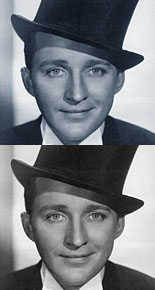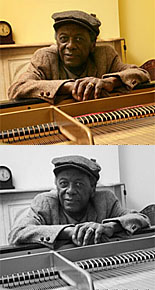Home » Jazz Articles » Old, New, Borrowed and Blue » Soul And The Abstract Proof: Searching For Soul And Its ...
Soul And The Abstract Proof: Searching For Soul And Its Meaning In Jazz
For some people, soul and jazz are separate entities, never to merge in sound. The music of Motown or Ray Charles' records are often held up as prime examples of soul for the masses, and jazz doesn't even get brought into the equation...or does it? Standing In The Shadows Of Motown (Lions Gate, 2003) told the untold story of the oft-uncredited backing musicians who brought Motown's music to life and the large majority of them were actually jazz musicians who took a different path. While the story of these musicians might not be familiar to jazz fans, a large percentage of them probably know of Ray Charles' jazz connections with artists like Hank Crawford, David "Fathead" Newman and many others. Music fans and critics would probably categorize all of this as a jazz influence seeping into soul music, but what about the opposite. How do you define jazz with a soul influence? While I certainly don't claim to fully know the answer to that question, and anybody who does probably has a bridge to sell you, I can say that it's like determining whether or not your car needs new brakes—you know it when you hear it! With that in mind, this edition of Old, New, Borrowed and Blue will focus on soul in jazz.
Old
 Charles Mingus' music means many things to many people, but my first encounter with his work dealt more with his compositional acumen and brilliance with a pen than with soulful sounds. In my search for knowledge and continued explorations into uncharted musical waters, I checked out a copy of Let My Children Hear Music (Columbia, 1971) from my local library and it took my breath away. This album presented dense, moving music like I had never heard before—nor since—and it left me wanting to learn more about Mingus' music. Interestingly enough, it also left me assuming that all of Mingus' music would have a similar sound and vibe. The moment when I realized I was wrong came soon after, when I encountered my favorite Mingus composition—"Better Git it In Your Soul."
Charles Mingus' music means many things to many people, but my first encounter with his work dealt more with his compositional acumen and brilliance with a pen than with soulful sounds. In my search for knowledge and continued explorations into uncharted musical waters, I checked out a copy of Let My Children Hear Music (Columbia, 1971) from my local library and it took my breath away. This album presented dense, moving music like I had never heard before—nor since—and it left me wanting to learn more about Mingus' music. Interestingly enough, it also left me assuming that all of Mingus' music would have a similar sound and vibe. The moment when I realized I was wrong came soon after, when I encountered my favorite Mingus composition—"Better Git it In Your Soul." When I first heard this song on Mingus Ah Um (Columbia, 1959), I felt like I was going to jump out of my skin. I've read of Nat Hentoff's initial encounter that pulled him into jazz— when he first heard Artie Shaw's "Nightmare"—and, though it would take me several years to get fully sucked into this music after this incident, my reaction to this Mingus song was on a similar "gut" level. The sheer passion in this music and the balance between looseness and ensemble brilliance was something I had never encountered before. As a percussionist, my initial focus was on Dannie Richmond's drumming, but after I made a few sloppy attempts to play along with the song, I just sat and listened. In subsequent years, I had the pleasure of hearing the piece performed as part of the large-scale production of Mingus' Epitaph at Jazz At Lincoln Center and I encountered Woody Herman's stellar big band take on the song, but neither of these encounters proved to match the soul quotient of the original.
New
 In August of 2010, I made my first visit to the Litchfield Jazz Festival in Connecticut. Before arriving, I was familiar with the the music of many of the artists on the bill—including Anat Cohen, Avery Sharpe and Arturo O'Farrill—but I was also eager to hear some music that I hadn't already encountered. Over the course of my two days on the festival grounds, I heard plenty of new sounds, but one particular performance really grabbed me and never let go. Gerald Clayton might have come onto the scene being referenced as "bassist John Clayton's son" or "saxophonist Jeff Clayton's nephew," but his individual talents and personal sound have helped him shed the genealogical tags that plague so many jazz offspring. In fact, I wouldn't be surprised if the jazz press eventually refers to one of the elder Clayton's as a relative of Gerald!
In August of 2010, I made my first visit to the Litchfield Jazz Festival in Connecticut. Before arriving, I was familiar with the the music of many of the artists on the bill—including Anat Cohen, Avery Sharpe and Arturo O'Farrill—but I was also eager to hear some music that I hadn't already encountered. Over the course of my two days on the festival grounds, I heard plenty of new sounds, but one particular performance really grabbed me and never let go. Gerald Clayton might have come onto the scene being referenced as "bassist John Clayton's son" or "saxophonist Jeff Clayton's nephew," but his individual talents and personal sound have helped him shed the genealogical tags that plague so many jazz offspring. In fact, I wouldn't be surprised if the jazz press eventually refers to one of the elder Clayton's as a relative of Gerald! On this particular weekend, Gerald Clayton had his trio in tow and they were at Litchfield in support of his fantastic Two-Shade (ArtistShare, 2009). The trio's set took them through hip originals from the album—like the instantly enjoyable and humorous "Two Heads One Pillow"—but the high point of the set came with Clayton's new spin on an old favorite. Before beginning "Con Alma," Clayton joked that the translation of the song title was "with Alma," but a good part of the crowd seemed to know that "alma" actually meant "soul." Clayton managed to take this classic from the Dizzy Gillespie book and transform it into a piece characterized by rhythmic joie de vivre, rhapsodic intentions and a wide dramatic arc, while maintaining the soulful essence and melodic intentions embedded deep within this composition. I went to Litchfield knowing little about Clayton's own music, but I left as a devoted fan of his work.
Borrowed
 The legendary James Brown was often called "The Hardest Working Man in Show Business," but one of his many other nicknames was "Soul Brother #1." Different people fondly recall Brown's career for different reasons. Some remember his reputation as a strict band leader and others respect his abilities as an unparalleled entertainer. Drummers will forever appreciate how his music fused soul and funk—with Clyde Stubblefield and/or John "Jabo" Starks laying down the grooves—while saxophonists will always think of Brown's hellacious hornmen like Maceo Parker and Pee Wee Ellis. The mention of Ellis and Parker, of course, hints at a jazz connection within Brown's work, but the most overt overlap between the world of Brown's soul and straight up jazz came with a one-off collaboration between Brown, drummer Louie Bellson and arranger Oliver Nelson, called Soul On Top (Verve, 1969).
The legendary James Brown was often called "The Hardest Working Man in Show Business," but one of his many other nicknames was "Soul Brother #1." Different people fondly recall Brown's career for different reasons. Some remember his reputation as a strict band leader and others respect his abilities as an unparalleled entertainer. Drummers will forever appreciate how his music fused soul and funk—with Clyde Stubblefield and/or John "Jabo" Starks laying down the grooves—while saxophonists will always think of Brown's hellacious hornmen like Maceo Parker and Pee Wee Ellis. The mention of Ellis and Parker, of course, hints at a jazz connection within Brown's work, but the most overt overlap between the world of Brown's soul and straight up jazz came with a one-off collaboration between Brown, drummer Louie Bellson and arranger Oliver Nelson, called Soul On Top (Verve, 1969). Brown and Bellson originally met at one of Pearl Bailey's shows at the Apollo Theatre, but the idea of a collaboration didn't come up until Brown mentioned it at a later encounter in 1968. Less than a year later, they crossed paths again and the initial idea began to take shape. Despite the fact that Bellson was no slouch with a pen, Oliver Nelson ended up being drafted to write the arrangements. Nelson—best known to jazz fans for his classic, Blues And The Abstract Truth (Verve, 1961)—gets to the heart of soul and the abstract proof of its connection to jazz on this album.
The big band on the record features some top drawer jazz talent like saxophonist Ernie Watts, trombonist Jimmy Cleveland, bassist Ray Brown and Bellson on drums. Brown's main man on saxophone—Maceo Parker—was part of the date as well, and the repertoire was as eclectic as could be. The program consisted of Brown hits like "It's A Man's, Man's, Man's World" and "Papa's Got a Brand New Bag," standards ("It's Magic"), re-worked country fare ("Your Cheatin' Heart"), blues ("Every Day I Have The Blues"), a Bellson original ("I Need Your Key (To Turn Me On)") and some other interesting choices, but these three different artists met on common ground to bring a unified sound to the music. While one or two tracks—like the over-funked up take on "September Song"—might come off as contrived to some listeners, the majority of the music finds hits the right tone. This under-appreciated classic was reissued in 2004 and Brown's quote on the back of the CD really strikes a chord about the connections between soul and jazz in his music:
"When people talk about soul music, they only talk about gospel and r&b coming together. That's accurate about a lot of soul, but if you are going to talk about mine, you have to remember the jazz in it. That's what made my music so different and allowed it to grow."
One only needs to listen to the version of "It's A Man's, Man's, Man's World" on this album—which begins with a riff that bears some resemblance to the "Better Git It In Your Soul" lick—to observe how soul and jazz became one.
Blue
 While 1959 is forever remembered as a pivotal year in the history of jazz because of ground-breaking albums like Miles Davis' Kind Of Blue (Columbia, 1959), Dave Brubeck's Time Out (Columbia, 1959) and the previously discussed Mingus Ah Um (Columbia, 1959), plenty of other impressive artistic statements were coming out of the studios at this time. In September of that year, Orrin Keepnews convened a session for a new album from trumpeter Blue Mitchell that—in Keepnews' own words—helped the trumpeter step "over the invisible line" from a "promising artist" to a musical force that made good on that promise and had "arrived." The album—Blue Soul (Riverside, 1959)—featured a sextet on some of the tracks and pared things down to a quartet on some others, and the album as a whole struck a good balance between individualistic instrumental endeavors and tightly woven arrangements. Benny Golson arranged and/or wrote a good deal of the material on the album, while Jimmy Heath—who also held the tenor saxophone chair on the recording— arranged two of his own pieces for the affair.
While 1959 is forever remembered as a pivotal year in the history of jazz because of ground-breaking albums like Miles Davis' Kind Of Blue (Columbia, 1959), Dave Brubeck's Time Out (Columbia, 1959) and the previously discussed Mingus Ah Um (Columbia, 1959), plenty of other impressive artistic statements were coming out of the studios at this time. In September of that year, Orrin Keepnews convened a session for a new album from trumpeter Blue Mitchell that—in Keepnews' own words—helped the trumpeter step "over the invisible line" from a "promising artist" to a musical force that made good on that promise and had "arrived." The album—Blue Soul (Riverside, 1959)—featured a sextet on some of the tracks and pared things down to a quartet on some others, and the album as a whole struck a good balance between individualistic instrumental endeavors and tightly woven arrangements. Benny Golson arranged and/or wrote a good deal of the material on the album, while Jimmy Heath—who also held the tenor saxophone chair on the recording— arranged two of his own pieces for the affair. Golson's "Park Avenue Petite" gave Mitchell a chance to show off his sound on a classy ballad with noir-ish sensibilities and "The Head" is a good example of a tune that let Mitchell cut loose and cook over a hard swinging rhythm section, but the title track is, appropriately enough, the best example of soul-meets-jazz. The sextet became a quartet—with Heath and trombonist Curtis Fuller sitting out—and Mitchell used the opportunity to gel with his blues-capable rhythm section. Understated soul, as filtered through the 12-bar blues, is at the core of this performance and pianist Wynton Kelly is a key ingredient in the mix. Whether simply comping with some soulful tremolo licks or soloing with his inimitable blues inflections, Kelly makes this one cook despite a tempo that is merely moderate. Bassist Sam Jones contributes some enjoyable solo work on this one and Philly Joe Jones locks in well with his fellow rhythm section mates. The James Brown album might have had soul on top, but "Blue Soul" has it underneath the surface, hiding deep within Mitchell's trumpet work, Kelly's piano and the Jones-men's rhythm work.
Stay tuned for more Old, New Borrowed and Blue.
Tags
Old, New, Borrowed and Blue
Dan Bilawsky
United States
duke ellington
Ray Charles
Hank Crawford
David "Fathead" Newman
Charles Mingus
Dannie Richmond
Woody Herman
Anat Cohen
Avery Sharpe
Arturo O'Farrill
Gerald Clayton
John Clayton
Jeff Clayton
Dizzy Gillespie
James Brown
Maceo Parker
Pee Wee Ellis
Louie Bellson
Oliver Nelson
Pearl Bailey
ernie watts
Jimmy Cleveland
Ray Brown
Miles Davis
Dave Brubeck
orrin keepnews
Blue Mitchell
benny golson
Jimmy Heath
Curtis Fuller
Wynton Kelly
Sam Jones
Philly Joe Jones
PREVIOUS / NEXT
Support All About Jazz
 All About Jazz has been a pillar of jazz since 1995, championing it as an art form and, more importantly, supporting the musicians who make it. Our enduring commitment has made "AAJ" one of the most culturally important websites of its kind, read by hundreds of thousands of fans, musicians and industry figures every month.
All About Jazz has been a pillar of jazz since 1995, championing it as an art form and, more importantly, supporting the musicians who make it. Our enduring commitment has made "AAJ" one of the most culturally important websites of its kind, read by hundreds of thousands of fans, musicians and industry figures every month.


























